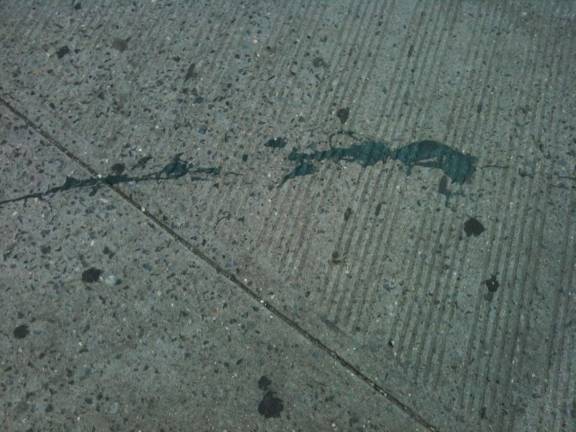On the green-paint Trail First Person

Because I am way past 60, and use a cane when I walk, I tend to focus my gaze on the ground. One day I noticed a squiggly lamppost green paint trail on the east sidewalk of Lexington Avenue. A line of drops, blobs and dribbles entered the sidewalk from the street at the southeast corner of 38th Street and continued to 40th, where it turned and headed down towards Third. Intrigued, I decided to investigate.
I followed the paint back to the northwest corner of 37th & Park. Surrounding one of two manholes in the middle of the sidewalk was an accumulation of green drips and streaks. This was the trail’s starting point. Just to be sure, I walked down the rest of the block to Madison. Close to the Polish Embassy there was an in-ground 7-inch water cover freshly painted a similar green, but without any matching blobs or squiggles on the gray cement. Evidently, a paint-carrying trolley had made it from the water cover and most of the way down the block to the first manhole without spilling a drop, but the uneven lid of a second one caused the sputtering spill.
Following the paint, I crossed Park Avenue and interpreted the heavy dribble at the center median to mean that the painter must have had to wait before crossing the divided avenue. On the east side of Park, between 37th and 38th Streets, wide-spaced drips indicated that the can was rapidly towed in front of the Guatemalan Mission to the United Nations and The Church Of Our Saviour. At the corner, it stopped and doubled back on itself several times, suggesting that the worker wasn’t as patient while waiting for this light to change. Then the pigment angled into the street and disappeared.
As much as the traffic allowed, I examined the black tar for green spots but couldn’t find any. I crossed to the uptown side and hunted there. Still no paint splashes. I knew the paint splotches continued on Lexington, but what happened to them on 38th Street? Did a laborer walk in the street until Lexington where car tires eventually obliterated the drops?
Not having any luck picking up the trail again, I went back to the origin, on the corner of 38th & Lex. From there I followed thick and thin streaks, and an occasional curlicue, until the corner of 40th, and then around and down the hill to the west side of Third Avenue between 41st and 42nd. There the paint ended at the curb. Most probably, the trolley and the now almost-empty can were loaded onto a truck and taken to where another 7-inch water cover needed painting, although I doubted if there was enough paint left to cover even a 3-inch drain.
As I scrutinized the pavement, other thoughts occurred, and I became very curious as to why sidewalks were made the way they were. This, perhaps, was solvable. I emailed the Department of Transportation with questions.
A return message told me that there are roughly 1,160 miles of sidewalk in Manhattan. But in landmarked areas, such as Murray Hill, when a section of sidewalk needs fixing, it must be repaired with the similar material as the original, i.e. slate has to repair slate and granite has to replace granite. As for the concrete, DOT requires light, unpigmented gray, although some commercial buildings may use pigmented with departmental approval. To make the walkway as even as possible, when one section is noticeable higher than another, it is ‘shaved down’ with a grinding machine. DOT periodically inspects the sidewalks but maintenance is generally the owners’ responsibility. The Department of Parks and Recreation has authority over the sidewalk trees, their pits and fences.
Joe Battaglia from J.B. General Contracting in Ozone Park provided me with the answers to the rest of my questions. He told me that when laying a new sidewalk, their company tries to match or complement the style of the rest of the block, unless the architect specifies otherwise. The groves that give the squares or rectangles their shape, called control joints, are necessary to help prevent surface cracking. And to prevent water from seeping under the slabs, polyurethane caulking is added around each section. The width of the edger used creates the “frame: inside each square. The amount of black stones visible in the concrete is caused by the age of the sidewalk, not by any particular mixture of cement and aggregate.
On my journey along the green trail, the two things I did not encounter were litter and dog poop – wonderful omissions for the city’s pedestrians. Because of the BIDs, the pooper scooper law, and New Yorkers becoming neater, city sidewalks, at least on the Upper East Side, are clean. And with the help of a trail of lamppost green paint, they’re also intriguing.